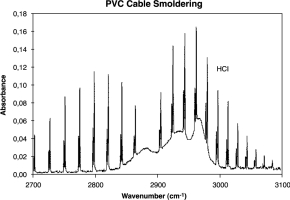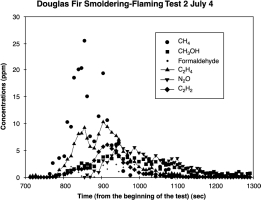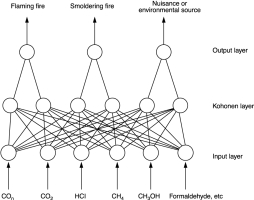
Future fire detection systems should have the ability of discriminating signatures between fire and non-fire sources, because nuisance alarm problems have plagued existing smoke detectors.
In high value installations such as semiconductor clean rooms and telephone central offices, it is obvious that reliable fire detection systems are needed, since usually these detection systems are used to activate fixed fire suppression systems and false discharges are certainly undesirable. False alarms can cause unnecessary down time and undermine the operator's confidence in the monitoring systems. In light of these, a new fire detection system using infrared diagnostics (FT-IR spectroscopy) together with advanced signal processing technique (artificial neural networks) has been developed at Advanced Fuel Research ( www.afrinc.com). This new fire detection system promises to provide an early warning of hazardous conditions and has the ability to determine whether the hazardous conditions are from fire or nuisance/environmental sources.
Approach
It has been shown that multiparameter fire detection systems are inherently more reliable than any single parameter measurement and can be made robust by the use of artificial intelligence methods. The objective of Advanced Fuel Research's research efforts is to use an advanced Fourier Transform Infrared gas analyser to develop an intelligent fire detection system that can be used in high value facilities. The company has made extensive FT-IR gas measurements of flaming and smouldering fires as well as environmental/nuisance sources. The FT-IR measurements were made in open-path, cross duct, and extractive modes for flaming fires, while measurements of smouldering fires and environmental/nuisance sources were performed in extractive mode, since most of the current fire detection technologies (eg, VESDA and AnaLaser) for cleanrooms and telephone central offices are based on air sampling techniques in which the air samples from multiple locations of the rooms are drawn and delivered through an extensive piping network to a particle analyser. The FT-IR system can be easily incorporated in this type of fire detection system, and comparison can be made with existing technologies.
Numerous materials were tested, including polyurethane (PU), polyvinylchloride (PVC), polymethylmethacrylate (PMMA), polypropylene (PP), polystyrene (PS), Douglas Fir wood (DF), low density polyethylene (LDPE), aqueous ammonia (NH3), tetrafluoromethane (CF4), isopropanol alcohol (IPA), cables, etc. Figure 1 shows part of a spectrum (2700-3100 cm-1) from a smouldering fire of a regular extension cable (with a PVC jacket). The evolution of HCl is evident, although the HCl band is overlapped somewhat with a hydrocarbon band.

Figure 2 shows concentrations of some fuel specific species. N2O and formaldehyde were clearly observed in a smouldering-flaming Douglas Fir fire test shown in the figure. Similar observations can be made for other materials tested.

The species concentrations measured by an FT-IR, together with a neural network and fuzzy logic models, can be used to identify whether there is a fire or nonfire (environmental/nuisance) event and to classify whether it is a flaming or smouldering fire if the event is indeed a fire. A commercially available neural network software package, NeuralWorks Professional II/Plus (), was chosen to build the needed neural network. A so-called Learning Vector Quantisation (LVQ) network has been built and tested (Figure 3). The inputs to the network at this moment are concentrations (18 species from FT-IR measurements) of CO2, CO, H2O, CH4, CH3OH, formaldehyde, HCl, C2H4, N2O, NH3, CF4, NO, methyl methacrylate, isopropanol alcohol, C2H6, C3H6, C6H14, C2H2, C6H6. The outputs of the network are classification of the input data as a flaming fire, smouldering fire, or nuisance/environmental source. The results were very successful, as among the 248 cases tested only 12 cases were misclassified, most due to the difficulties in classifying the modes of combustion during a transition from smouldering to flaming fire.

Advanced Fuel Research has incorporated the above-trained LVQ network into its data acquisition system that connects with an On-Line 2010 multigas spectrometer. A realtime fire detection system has been constructed. Preliminary tests of this integrated software have been satisfactory using the test data we described above.
However, these tests are in no way rigorous, as only data from a single test arrangement has been used. New tests (other burning materials, geometric arrangement, etc) are needed in order to validate the accuracy and improve the robustness of the new fire detection.
References
Milke, JA and McAvoy, TJ, Analysis of signature patterns for discriminating fire detection with multiple sensors, Fire Technology, Second Quarter 1995.
Serio, MA, Bonanno, AS, Knight, KS, Wójtowicz, MA and Solomon, PR, Advanced infrared systems for detection of building fires, Final Report to DOC under Contract No. 50-DKNA-4-000-96, February 1995.
Okayama, Y, Ito, T and Sasaki, T, Design of neural net to detect early stage of fire and evaluation by using real sensors' data, Fire Safety Science-Proc. of 4th Int'l Symposium, pp. 751-759, 1993.
Okayama, Y, A primitive study of a fire detection method controlled by artificial neural net, Fire Safety Journal, pp. 535-553, 17, 1991.
Chen, Y, Sathyamoorthy, Y, And Michael A. Serio, An intelligent fire detection system using advanced infrared diagnostics and neural network techniques, The Eastern States Meeting of the Combustion Institute, October, 1997.
NeuralWare, Inc., NeuralWorks Professional II/Plus, Version 5.3, February 1997.
For more information contact Mike Serio, Advanced Fuel Research, [email protected], www.afrinc.com

© Technews Publishing (Pty) Ltd. | All Rights Reserved.